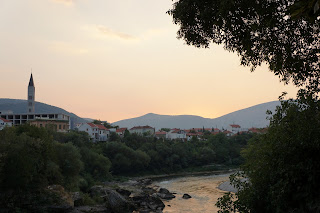In visiting Sarajevo, and exploring Bosnia and Herzegovina a little more generally, I have been able to tick one off mine. Ever since I first saw the images of the conflict in the Balkans, and of the siege of Sarajevo, I wanted to visit not because I am a war junky, but because I wanted to understand how and why such a series of horrific events could occur so recently and so close to western Europe. Reading and studying a number of reports on the conflict, the abuses and incidents did not answer many of the questions I had.
From visiting the region, seeing many burnt out or shot up buildings (some still with sandbags), and having had the opportunity to talk with a number of bravely honest individuals (a long and confronting chat with a 26 year old resident of Mostar is one that I will remember for a long time - the title of this post is a quote from him), I feel that I have a better sense of what occurred but may never really appreciate the key question, why.
Sarajevo is an interesting and vibrant city. The many pedestrianised streets of the old town and the area to the west are charming, filled with people (many people sitting having a conversation over coffee) and have a great buzz.
Bars, restaurants and cafes are everywhere and some streets turn into seas of tables at night. One night we watched FK Sarajevo play the second round of a Europa League qualifying tie in one such street. With 15 tv screens placed throughout an excited and interested crowd, it was quite an experience.
Through a couple of self guided city tours, we visited the Latin Bridge (where the Archduke and his wife were assassinated, triggering world war one), walked down a number of sniper alleys, saw a number of the Sarajevo roses and had lunch on the steps of the rebuilt parliament buildings (the image of it on fire is one that I remember). Near the parliament building is the Holiday Inn, a "safe" hotel where journalists were accommodated during the siege. While the facade has mostly been replaced, there are still some shrapnel marks. We also visited the desperately underfunded historical museum, which has a permanent exhibition on how the city operated during the siege and had two temporary photographic exhibitions comprising some very confronting images of the siege and the conflict more generally.
From Sarajevo we boarded a bus and travelled down to Mostar. Mostar being famous for one of its bridges, which during the conflict was blown up symbolically and practically separating the city.
While much work, and money, has gone into rebuilding parts of the town (the old town, which housed the bridge, was almost totally destroyed), there are still many reminders of the conflict. In some streets, including on each of the streets people walk down from the train/bus station to the old town (where most of the accommodation, restaurants and bars are) almost every building sports some scars from the conflict. Some buildings remain totally destroyed, some still with sandbags and some shot up and abandoned. For our tour guide (on one of the days we did a tour out of town which I talk about below), it is the repaired buildings, including the mosques (he told me every mosque in town was badly damaged during the conflict), that remind and haunt him the most.
I am so lucky to have been born to the family I was and grown up where I did.
On a day trip out from Mostar, we visited the Medugorje and the Kravice waterfalls. The Medugorje was little known until 1981 when a group of teenagers claim they were spoken to by the Virgin Mary on a hill overlooking the town. Even though the Vatican has not acknowledged that the events took place, millions of pilgrims have visited since. The main Catholic church in town is quite a place, with 25+ confession booths (with the languages spoken by the priest written above the door), services conducted daily in a number of languages and parking for thousands. The waterfalls, which are hidden in a gully in the dessert like landscape, provided a nice break from the heat (according to our guide it was too cool for him to swim with the air temperature only 35 degrees).
From Mostar, we took an epic seven and a half hour, four border crossing, bus ride to Budva in Montenegro, where I sit writing this.











































